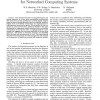Free Online Productivity Tools
i2Speak
i2Symbol
i2OCR
iTex2Img
iWeb2Print
iWeb2Shot
i2Type
iPdf2Split
iPdf2Merge
i2Bopomofo
i2Arabic
i2Style
i2Image
i2PDF
iLatex2Rtf
Sci2ools
HICSS
2002
IEEE
2002
IEEE
On the Performance of a Survivability Architecture for Networked Computing Systems
This research focuses on the performance and timing behavior of a two level survivability architecture. The lower level of the architecture involves attack analysis based on kernel attack signatures and survivability handlers. Higher level survivability mechanisms are implemented using migratory autonomous agents. The potential for fast response to, and recovery from, malicious attacks is the main motivation to implement attack detection and survivability mechanisms at the kernel level. A timing analysis is presented that suggests the real-time feasibility of the two level approach. The limits to real-time response are identified from the host and network point of view. The experimental data derived is important for risk management and analysis in the presence of malicious network and computer attacks.
| Added | 14 Jul 2010 |
| Updated | 14 Jul 2010 |
| Type | Conference |
| Year | 2002 |
| Where | HICSS |
| Authors | William S. Harrison, Axel W. Krings, Nadine Hanebutte, Miles McQueen |
Comments (0)

